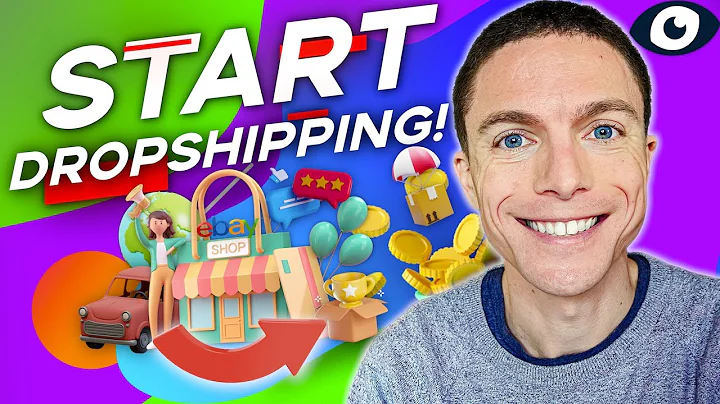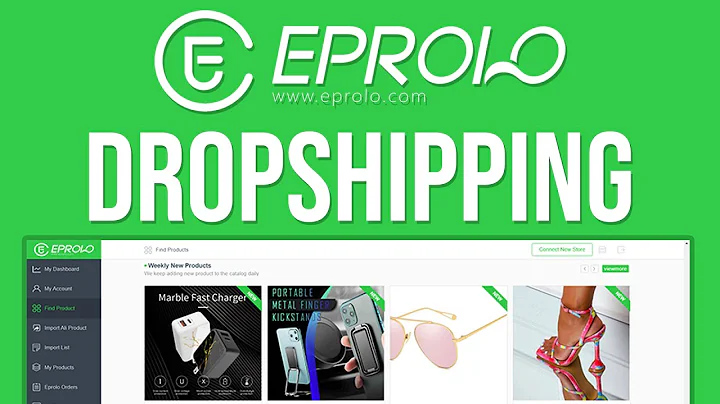Selling on Amazon without Inventory: A Beginner's Guide
Table of Contents:
- Introduction
- The Benefits of Selling on Amazon
- The Challenges of Selling on Amazon
- Selling on Amazon without Inventory
4.1. Amazon FBA (Fulfilled by Amazon)
4.2. Amazon Merch
- Selling on Amazon with Minimal Investment
5.1. Selling Products from Wholesale Suppliers
5.2. Dropshipping on Amazon
- The Power of Keywords and SEO on Amazon
6.1. How to Find Profitable Keywords
6.2. Optimizing Product Listings for SEO
- Building a Brand and Getting Reviews on Amazon
7.1. Creating a Unique Brand Identity
7.2. Strategies for Getting Positive Reviews
- Scaling Your Amazon Business
8.1. Expanding Product Offerings
8.2. Advertising and Promotions on Amazon
- Tips for Success on Amazon
9.1. Staying Updated with Amazon Policies
9.2. Building Relationships with Customers
- Conclusion
Selling on Amazon: A Guide to Success
Introduction
Selling products on Amazon has become a lucrative business opportunity for many entrepreneurs. With millions of customers and a trusted platform, Amazon provides an ideal marketplace for sellers to reach a wide audience and generate significant profits. However, navigating the world of Amazon selling can be challenging, especially for beginners who may not have the resources or experience to invest in inventory. In this article, we will explore various strategies to sell on Amazon without the need for inventory, as well as tips for success in building a profitable Amazon business.
The Benefits of Selling on Amazon
Selling on Amazon offers numerous advantages for entrepreneurs. One of the major benefits is the access to a vast customer base. With millions of active users, Amazon provides sellers with unparalleled visibility and potential for sales. Additionally, Amazon takes care of the logistics and customer service, allowing sellers to focus on growing their business rather than dealing with the operational aspects of order fulfillment. Furthermore, Amazon offers various marketing tools and advertising options to help sellers promote their products and increase visibility.
The Challenges of Selling on Amazon
Although selling on Amazon has its benefits, it also poses certain challenges. One of the main challenges is competition. With millions of sellers vying for customers' attention, it can be difficult to stand out and attract sales. Moreover, Amazon's algorithms and ranking system determine product visibility, making it crucial for sellers to optimize their listings and leverage keywords effectively. Additionally, managing inventory, handling customer inquiries, and complying with Amazon's policies and guidelines can be time-consuming and complex.
Selling on Amazon without Inventory
Traditionally, selling on Amazon has required sellers to invest in inventory, which can be a significant financial burden, especially for beginners. However, there are alternative methods that allow sellers to enter the Amazon marketplace without the need for inventory.
Amazon FBA (Fulfilled by Amazon) is a program that enables sellers to store their products in Amazon's fulfillment centers. Once an order is placed, Amazon handles the packaging, shipping, and customer service. This eliminates the need for sellers to manage their own inventory and provides a seamless experience for customers. However, Amazon FBA does require an initial investment in inventory.
Another option for selling on Amazon without inventory is Amazon Merch. This platform allows sellers to design and sell custom-branded t-shirts, hoodies, and other merchandise. Sellers simply upload their designs, set the prices, and Amazon takes care of the printing, shipping, and customer service. This eliminates the need to invest in inventory or handle fulfillment operations.
Selling on Amazon with Minimal Investment
For those who have a limited budget and want to sell on Amazon, there are strategies that require minimal investment.
Selling products from wholesale suppliers is a popular method for sourcing inventory. By partnering with wholesalers, sellers can purchase products at discounted prices and resell them on Amazon. This approach requires some upfront investment but allows for greater profit margins compared to traditional retail arbitrage.
dropshipping is another option for selling on Amazon with minimal investment. With dropshipping, sellers list products on Amazon that are sourced from a supplier. When a customer places an order, the seller transfers the order details to the supplier, who then fulfills the order and ships it directly to the customer. This eliminates the need for inventory management and allows sellers to focus on marketing and customer service.
The Power of Keywords and SEO on Amazon
To succeed on Amazon, sellers must understand the importance of keywords and search engine optimization (SEO). By strategically incorporating relevant keywords into product titles, descriptions, and backend fields, sellers can increase their visibility in Amazon's search results and attract more customers.
Finding profitable keywords requires thorough research. Sellers can use keyword research tools to identify popular search terms related to their product niche. By targeting keywords with high search volume and low competition, sellers can improve their chances of ranking higher in Amazon's search results.
Optimizing product listings is essential for effective SEO on Amazon. Sellers should ensure that their titles, bullet points, and descriptions clearly and accurately describe their products while incorporating relevant keywords. Additionally, using high-quality images and optimizing backend fields, such as search terms and subject matter, can further improve visibility and conversion rates.
Building a Brand and Getting Reviews on Amazon
Building a brand on Amazon is essential for long-term success. Creating a unique brand identity helps sellers differentiate themselves from competitors and build trust with customers. By focusing on product quality, packaging, and branding, sellers can establish a loyal customer base and generate repeat sales.
Obtaining positive reviews is crucial for increasing sales and building social proof on Amazon. Sellers can encourage customers to leave reviews by providing exceptional customer service, following up with buyers after their purchase, and offering incentives for leaving feedback. It is important to note that Amazon has strict guidelines regarding review solicitation, so sellers should ensure compliance to avoid penalties.
Scaling Your Amazon Business
Once a seller has established a successful selling strategy on Amazon, it is essential to scale the business to maximize profits and reach new customers.
Expanding product offerings is a proven way to increase sales and appeal to a wider audience. Sellers can identify complementary products or explore new product niches to diversify their offerings. By expanding the product catalog, sellers can leverage existing customer relationships and cross-promote products, leading to higher average order values and increased customer loyalty.
Advertising and promotions play a significant role in scaling an Amazon business. Amazon offers various advertising options, such as sponsored product ads and display ads, which allow sellers to promote their products and increase visibility. Additionally, participating in Amazon's promotions, such as lightning deals and coupons, can attract new customers and generate a spike in sales.
Tips for Success on Amazon
To succeed on Amazon, sellers should keep a few key tips in mind:
- Stay updated with Amazon policies and guidelines to ensure compliance and avoid penalties.
- Build relationships with customers by providing exceptional customer service and following up after a purchase.
- Leverage tools and software to streamline operations and automate repetitive tasks.
- Monitor competitor strategies and industry trends to stay ahead of the curve.
- Continuously optimize product listings and marketing campaigns to improve visibility and conversion rates.
- Never stop learning and experimenting – Amazon's marketplace is dynamic, and sellers must adapt and evolve to stay competitive.
Conclusion
Selling on Amazon offers significant opportunities for entrepreneurs to start and grow a profitable business. Whether selling with inventory or without, leveraging strategies such as Amazon FBA, Amazon Merch, wholesale sourcing, dropshipping, and effective SEO can lead to success. By focusing on building a brand, obtaining positive reviews, scaling the business, and staying updated with Amazon's policies and guidelines, sellers can navigate the challenges and maximize their earning potential on Amazon.
Disclaimer: While selling on Amazon can be highly profitable, success is not guaranteed and requires hard work, dedication, and continuous learning. Results may vary based on individual effort and market conditions.



















